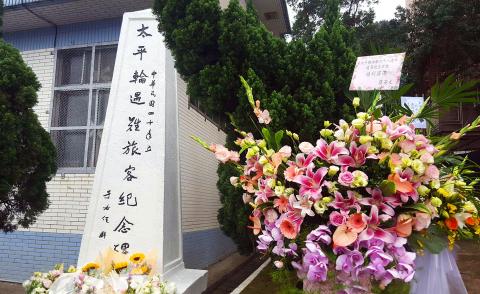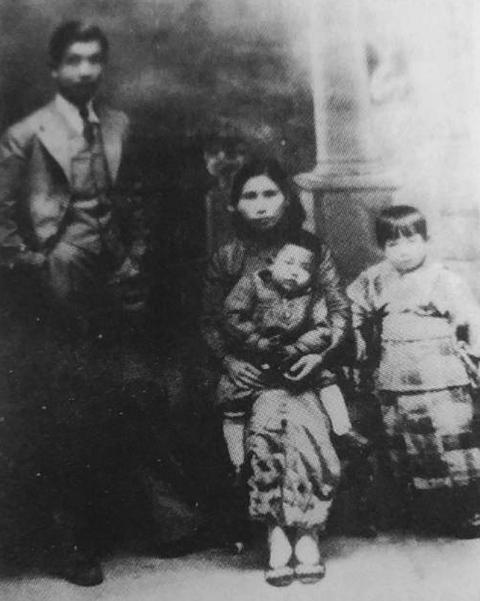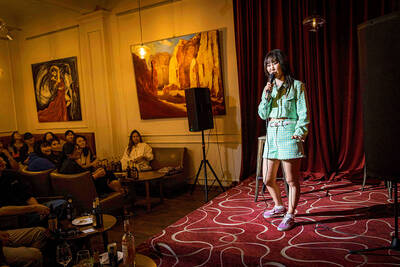Jan. 22 to Jan. 28
A nine-year-old Henry Lee (李昌鈺) was excited to be spending the Lunar New Year with his father, who would be arriving in Taiwan from China on a ship. Two days before the festivities, on Jan. 27. 1949, the future famous forensic scientist noticed that the adults were acting strangely. They did not tell him until two days later that his father had perished in the Taiping steamer (太平輪) tragedy.
More than 1,000 people died that night as the Taiping, which was headed from Shanghai to Keelung, collided with the Chienyuan (建元輪), a cargo ship from Taiwan. The Chienyuan immediately sank, while the Taiping went down 45 minutes later. About 50 people survived.

Photo: Yu Chao-fu, Taipei Times
The common version of events state that the crash occurred for several reasons, one being that the Taiping had exceeded its capacity with Chinese refugees escaping the Chinese Civil War, which had turned in favor of the Chinese Communist Party (CCP). It’s also said that it did not have its lights turned on because it was sailing during a nighttime curfew due to a delayed start. Some accounts also state that the captain had tried to take a shortcut.
Ting Wen-ching (丁雯靜) writes in the book, Taiping Steamer: Legend in Troubled Times (太平輪: 亂世傳奇真相), that through the making of a documentary on the incident, she began feeling that the official explanation was a bit fishy.
EYEWITNESS ACCOUNTS

Photo: CNA
Ting writes that the ship was flawed from the beginning. The Taiping was originally designed to traverse rivers and was only supposed to carry a maximum of 508 people. The boat also had too much cargo and likely more unregistered passengers who snuck on board. Lee’s father was one of them, making it onto the ship because he knew the captain. So was Chang Sheng (張生), one of the few Taiwanese on board who was returning home from a business trip.
The goods included official documents, bonds from the national treasury, rare antiques and the entire printing press of the Southeastern Daily (東南日報).
The passengers on the Taiping started rescuing the Chienyuan crew members until they realized that they too were sinking. Another ship had earlier passed the Taiping and asked them if they needed help. Not realizing the gravity of the situation, the Taiping replied, “All Okay.”
The Taiping crew attempted to steer the ship toward a nearby island — but it capsized 500 meters before landing. Survivor Lee Shu-wen (李述文) says that everyone fell into the water at once as the boat tipped over.
“I saw a sea of heads leaning on planks, tables and luggage,” he says. “Everyone was screaming... It was horrific to see and horrific to hear.”
It was around dawn when an Australian ship, the HMAS Warramunga, picked up 34 survivors from the wreckage. Almost all of them had at least one family member who didn’t make it.
John Simmons of the Warramunga still remembers the frightened expressions of the survivors, who were completely covered in oil that had leaked from the ship. “Besides their eyes and teeth, they were completely black,” he says.
DISPROVING THEORIES
Ting lists the various conspiracy theories that surround the incident: there was gold on board, a fight broke between Chinese Nationalist Party (KMT) and CCP spies, the ship was bombed and the captain of the ship was a Communist.
Since the wreckage has not yet been recovered, Ting writes that it’s hard to come up with a definite answer to quell the rumors. But she found many conflicting reports while interviewing eyewitnesses.
Ting questions whether the ship was overloaded, but concludes that even if it was, it did not necessarily lead to the crash. She focuses on why the ship’s departure was delayed — and traces it to a last-minute addition of 600 tonnes of steel bars. The ship would have left hours earlier if it did not have to wait for the bars to arrive.
Some reports say that the boat was speeding, but Ting argues that a river boat filled to the brim with people and cargo would not have been able to go too fast. As far as the two ships taking shortcuts, Ting maintains that both followed their regular courses, noting that there was not much reason for them to cut corners.
After extensive interviews with survivors, Ting finds that the ship indeed had its lights off at the time of the crash. But she then wondered why nobody saw the Chienyuan, which had its lights on.
One crew member first testified that nobody was on watch, as the third mate had left the cockpit to use the bathroom before the second mate arrived to take over. As the crash happened at 11:45pm, that was possible as his shift would have ended minutes later. But as a witness in court 90 days later, the crew member completely changed his statement, stating that they noticed the Chienyuan but could not get its attention.
Finally, she noticed that the steel bars were not on the inventory list of the ship, but almost all witnesses saw the bars being loaded. Historian Wang Feng (王丰) tells Ting that in those days many KMT officials were in the smuggling business as their salaries would not be enough to get their families out of the country if things went south.
“The Taiping was likely one of the vessels used by officials for smuggling. If it did not have to wait for those bars, it could have left Shanghai on time, and the ship may not have sunk,” Wang says. “These 600 tonnes of bars are an important clue.”
SLIGHTLY DIFFERENT VERSION
One of the other few recent books about the incident is Taiping Steamer 1949: Journey Toward Taiwan (太平輪一九四九:航向台灣) by Chang Tien-wan (張典婉), published in 2014.
Her version states that the ship was loaded far beyond capacity, and also mentions the 600 tonnes of steel bars that caused a delay. A frequent passenger tells her that he would normally have to climb a ladder to board, but the boat was so weighed down that he was able to walk on.
Chang’s story differs from Ting’s where she states that since the ship was running during curfew, it turned its lights off and took a shortcut to avoid running into the military. Her version also brings blame on the third mate, who she writes forgot to adjust the rudder because the first mate was drunk.
Taiwan in Time, a column about Taiwan’s history that is published every Sunday, spotlights important or interesting events around the nation that have anniversaries this week

Mongolian influencer Anudari Daarya looks effortlessly glamorous and carefree in her social media posts — but the classically trained pianist’s road to acceptance as a transgender artist has been anything but easy. She is one of a growing number of Mongolian LGBTQ youth challenging stereotypes and fighting for acceptance through media representation in the socially conservative country. LGBTQ Mongolians often hide their identities from their employers and colleagues for fear of discrimination, with a survey by the non-profit LGBT Centre Mongolia showing that only 20 percent of people felt comfortable coming out at work. Daarya, 25, said she has faced discrimination since she

It is one of the more remarkable facts of Taiwan history that it was never occupied or claimed by any of the numerous kingdoms of southern China — Han or otherwise — that lay just across the water from it. None of their brilliant ministers ever discovered that Taiwan was a “core interest” of the state whose annexation was “inevitable.” As Paul Kua notes in an excellent monograph laying out how the Portuguese gave Taiwan the name “Formosa,” the first Europeans to express an interest in occupying Taiwan were the Spanish. Tonio Andrade in his seminal work, How Taiwan Became Chinese,

April 21 to April 27 Hsieh Er’s (謝娥) political fortunes were rising fast after she got out of jail and joined the Chinese Nationalist Party (KMT) in December 1945. Not only did she hold key positions in various committees, she was elected the only woman on the Taipei City Council and headed to Nanjing in 1946 as the sole Taiwanese female representative to the National Constituent Assembly. With the support of first lady Soong May-ling (宋美齡), she started the Taipei Women’s Association and Taiwan Provincial Women’s Association, where she

More than 75 years after the publication of Nineteen Eighty-Four, the Orwellian phrase “Big Brother is watching you” has become so familiar to most of the Taiwanese public that even those who haven’t read the novel recognize it. That phrase has now been given a new look by amateur translator Tsiu Ing-sing (周盈成), who recently completed the first full Taiwanese translation of George Orwell’s dystopian classic. Tsiu — who completed the nearly 160,000-word project in his spare time over four years — said his goal was to “prove it possible” that foreign literature could be rendered in Taiwanese. The translation is part of